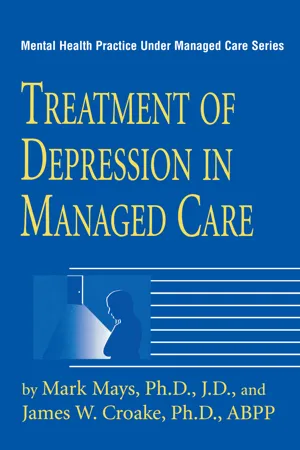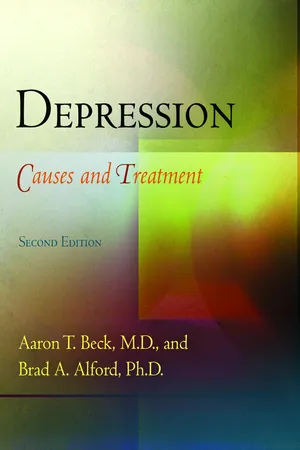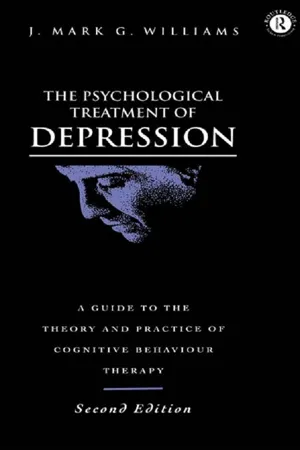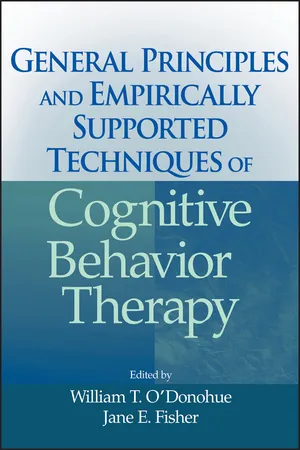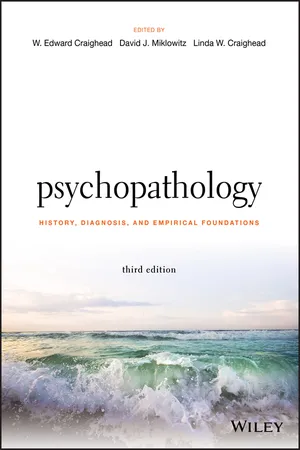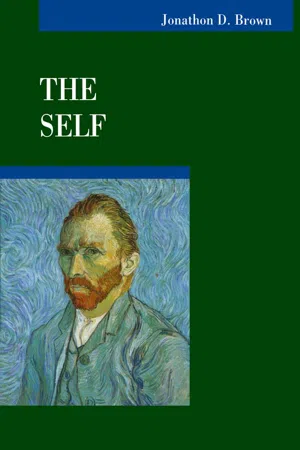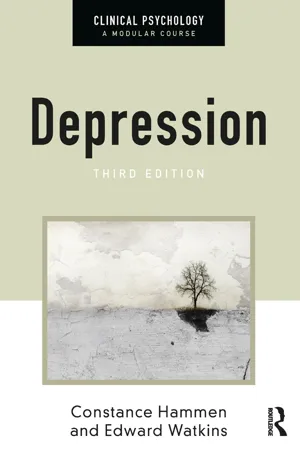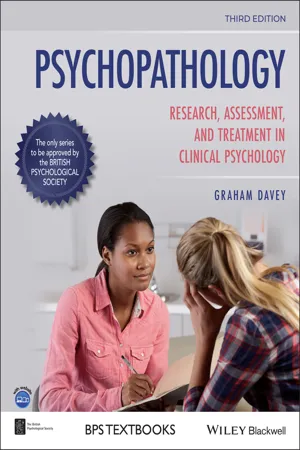Psychology
Theories of Depression
Theories of depression in psychology encompass various perspectives on the causes and mechanisms of depression. These theories include biological, cognitive, behavioral, and psychodynamic explanations. Biological theories focus on genetic, neurological, and biochemical factors, while cognitive theories emphasize distorted thinking patterns. Behavioral theories highlight the role of environmental triggers, and psychodynamic theories explore the influence of early experiences and unconscious processes.
Written by Perlego with AI-assistance
Related key terms
10 Key excerpts on "Theories of Depression"
- eBook - ePub
- Mark Mays, James W. Croake, Mark Mays, James W. Croake(Authors)
- 2013(Publication Date)
- Routledge(Publisher)
3 Theories of DepressionTreatment in the managed care environment requires specific knowledge about the conditions the provider is treating. Treatment planning is the core of managed care. With respect to depression, the therapist is fortunate, since there is no shortage of theories intended to illuminate and explain it. Theories range widely: from those that emphasize the biological underpinnings of depression to those mat focus on its social context, from those that look at behaviors to those that explore phenomenology or emotional experience, from the old to the new, and from the more simple to the ornately complex.Theories of Depression also vary in terms of the research supporting them. Within the social and medical sciences, empirical research has always been a way to validate theoretical understanding. Some theories, by their nature, lend themselves less well than others to empirical validation or refutation. Psychoanalytic theory is one of these. Other theories may be open to empirical inquiry, but practical considerations may constrain research efforts. For example, longitudinal research is expensive, and funding is often hard to obtain for studies that will not bear fruit for years, if at all. Theories that could be investigated by life-span research, therefore, will probably not be explored empirically. Funding for studies of drug effectiveness, relevant to certain biological theories, on the other hand, might be more available from the pharmaceutical companies that produce the antidepressant medicines being investigated. In short, there is hardly a consensus on the causes of depression, and the validation for the various views is often wanting.Biological TheoriesTheories of Depression can be easily divided into those that refer to biological causes and those that refer to psychological causes. Biological theories may well be historically the most accepted, and they have strong currency today. A review article by Lewis (1967) about melancholia notes that even Hippocrates proposed a biological basis for melancholia. He believed that the accumulation of “black bile and phlegm” affected one’s mood state, “darkening the spirit and making it melancholic.” - eBook - ePub
Depression
Causes and Treatment
- Aaron T. Beck, M.D., Brad A. Alford, Ph.D.(Authors)
- 2014(Publication Date)
- University of Pennsylvania Press(Publisher)
The paradigm of the primary triad shows the connections between the cognitive aspects described previously and the affective, motivational, and physical phenomena of depression. They are applicable to the various types of depression.Figure 12-1. The effect of cognitive patterns on affects and motivations in depression.The disturbances in depression may be viewed in terms of the activation of a set of three major cognitive patterns that force the individual to view self, world, and future in an idiosyncratic way. The progressive dominance of these cognitive patterns leads to the other phenomena that are associated with the depressive state.The first component of the triad is the pattern of construing experiences in a negative way. Patients consistently interpret their interactions with their environment as representing defeat, deprivation, or disparagement. They see their lives as filled with a succession of burdens, obstacles, or traumatic situations, all of which detract from them in significant ways.The second component is the pattern of viewing oneself in a negative way. Patients regard themselves as deficient, inadequate, or unworthy, and tend to attribute their unpleasant experiences to physical, mental, or moral defects in themselves. Furthermore, they regard themselves as undesirable and worthless because of the presumed defect and tend to reject themselves because of it.The third component consists of viewing the future in a negative way. Patients anticipate that their current difficulties or suffering will continue indefinitely. As they look ahead, they see a life of unremitting hardship, frustration, and deprivation.The relationship between the cognitive patterns and the affective and motivational symptoms is illustrated in Figure 12-1 . This relationship will be described in detail in later sections.Negative Interpretation of ExperienceDepressed patients selectively or inappropriately interpret their experiences as detracting from them in some substantive way. Whereas the manic sees neutral or ambiguous life situations as self-enhancing, the depressive regards them as self-deflating. The manic, for instance, may interpret a neutral attitude on the part of a friend as indicating overwhelming approval; the depressive may regard the same attitude as a rejection. This is particularly evident in patients with manic-depressive cycles who show completely opposite reactions to the same set of external conditions when they are in different phases of the cycle. - eBook - ePub
- J. Mark G. Williams(Author)
- 2013(Publication Date)
- Routledge(Publisher)
Chapter 10
The cognitive theory of depression revisited
Although it was not until the late 1960s and 1970s that experimental clinical psychologists started seriously to develop theories about the onset and maintenance of depression, even from these early theoretical writings there emerged a controversy about the necessity to postulate cognitive mediators. There are two forms of this debate, the first, with which we shall not be concerned here, is the philosophico-theoretical issue about the status of ‘private events’ and their explanatory power.The other debate is that between those who believe that cognitive events precede and cause the emotional disturbance, and those who believe that the emotional disturbance can be explained on other grounds (biological or behavioural) and see cognitive distortions and negative self-talk as a product or correlate of the emotional disturbance.Now this debate is crucial. If cognitive events are an epiphenomenon, accompanying though not playing a causal role in affective disorders, it would make less sense to devote years of research to how best to change cognitive styles or habitual self-talk strategies. Like ointment on a chickenpox rash, such treatment may soothe but have little prospect of treating the underlying disorder. Of course cognitive therapies do work (see Chapter Four ) but it may be that they are inadvertently affecting other more significant subsystems. Let us then examine the status of the aetiological cognitive thesis.Just to complicate matters further there are also two forms of the aetiological thesis. Let us call them the ‘precipitation theory’ and the ‘vulnerability theory’. The first is a ‘state’ theory and argues that moment-tomoment fluctuations in mood may in part be accounted for by the thoughts, images, and memories that occur to the individual. Controlling the nature, frequency or intensity of these thoughts and images will thereby affect the mood that is consequent upon them. The vulnerability theory argues that long-lasting styles of thinking (e.g. attributional style, tendency to selectively abstract or think dichotomously) occur prior to and render a person vulnerable to depressive breakdown in the face of stress. Although often confused under the general title of cognitive theory of depression, these theories are quite distinct and ought to be discussed separately. We shall consider the evidence for each in turn. - William T. O'Donohue, Jane E. Fisher, William T. O'Donohue, Jane E. Fisher(Authors)
- 2009(Publication Date)
- Wiley(Publisher)
Beck (1983) also claimed that two major dimensions of personality were important to depression: sociality, the tendency to readily form relationships, and individuality, the ability to see oneself as distinct. He also claimed that, while each of these two dimensions of personality could dominate in any individual at a given time, one of these typically was more influential in each depressive client. One client’s depression may stem from failure to achieve a life goal while another client’s depression may stem from the loss of a partner. Thus, there were two general modes or types of depression postulated: autonomous depression (or defeat/failure depression) and dependent depression (or deprivation depression). Beck (1983) then outlined the differences between individuals with these types of depression in premorbid personality, social factors contributing to the depression, maladaptive cognitive schemas, symptom patterns, and the effectiveness of therapeutic techniques.ALTERNATIVE Theories of Depression
A number of other theories of the etiology of depression have been critical in the continued development of cognitive behavioral therapy.Helplessness Theory of Depression
Abramson, Seligman, and Teasdale (1978) developed a theory of depression derived from the learned helplessness literature (Maier & Seligman, 1976). According to this theory, depression is the result of negative expectations about the outcome of situations and feeling hopeless about one’s ability to change those outcomes. Experiencing uncontrollable situations leads to decreased motivation, dysfunctional cognitions, and reduced self-esteem. Expectation that undesired outcomes will occur leads to hopelessness and other forms of negative affect.In this model, the development of depression is initially spurred on by the experience of non-contingency, where one experiences situations in which he or she does not appear to be able to control the outcomes. When this occurs, the individual begins to make attributions about the source of that helplessness. It is the character of these attributions that determines whether or not depression forms.- eBook - ePub
- Alan Carr(Author)
- 2003(Publication Date)
- Psychology Press(Publisher)
FEELINGS OF HAPPINESS AND sadness are adaptive. Many behaviour patterns that lead to happiness, such as socializing with others and developing longstanding friendships, are important for the survival of the species. Sadness, which commonly follows loss of valued objects, events, personal characteristics and skills or relationships, may also be adaptive, in that it reminds us to take care of valued objects, events, characteristics or relationships in future, lest we lose them again. Extreme mood states such as mania and depression are less adaptive. There is no doubt that, during periods of mania or hypomania, some individuals with bipolar disorder—which is characterized by episodes of mania and depression—produce highly creative work (Jamison, 1995). However, this is done at a high cost. Inevitably people who suffer from bipolar disorder, during a manic phase, run the risk of exhaustion, dehydration and excessive and dangerous risk-taking. Seasonal affective disorder (or winter depression as it is colloquially known) may be linked phylogenetically to hibernation and this may have been adaptive for our cave-dwelling ancestors. However, nowadays depression seems to fulfil no adaptive function. Despite this, it is a highly prevalent condition. Because of its prevalence, the main focus in this chapter will be on major depression, although reference will be made to other mood disorders such as bipolar disorder. Depression is not simply ‘feeling sad’. Major depression is a recurrent episodic condition involving low mood; selective attention to negative features of the environment; a pessimistic belief-system; self-defeating behaviour patterns, particularly within intimate relationships; and a disturbance of sleep and appetite.After considering the clinical features and epidemiology of depression, theoretical explanations for mood problems will be presented later in this chapter. Each of these specific explanations has been developed within the context of one of four broad theories. These are the biological, psychodynamic, cognitive-behavioural and family systems theories of psychological problems. In Chapter 6, these four broad theories are reviewed with reference to their main attributes, their contributions to our understanding and treatment of psychological problems, and their limitations.Case example
May, a single woman in her early thirties, was referred for counselling by her GP. She insisted on being seen by the psychologist at her house, since she had not been out of bed for two years. May had her first episode of depression in her mid-twenties after her first and only significant adult relationship with a man (Rob) ended. The episode lasted almost a year and consequently she lost her job as a teacher. During this first episode of depression she spent the time in bed. She lived in a small maritime town about 250 miles from the village where she grew up. Her mother came to stay with her during her first episode of depression. At her family doctor’s suggestion she also attended a series of counselling sessions which resulted in her recovery. Shortly after this the counsellor left the district. After a few months and a series of disappointing and unsuccessful attempts to rekindle old friendships, May relapsed. She spent two years in bed and refused to see anyone except her mother and the family doctor. - eBook - ePub
Psychopathology
History, Diagnosis, and Empirical Foundations
- W. Edward Craighead, David J. Miklowitz, Linda W. Craighead, W. Edward Craighead, David J. Miklowitz, Linda W. Craighead(Authors)
- 2017(Publication Date)
- Wiley(Publisher)
hopelessness depression is a subtype of depression wherein hopelessness is “an expectation that highly desired outcomes will not occur or that highly aversive outcomes will occur coupled with an expectation that no response in one's repertoire will change the likelihood of occurrence” (Abramson et al., 1989, p. 359). They viewed hopelessness as a proximal, sufficient cause of depression; in other words, if hopelessness is present, symptoms of depression likely will be present as well.Hopelessness theory posits that depression is more likely to occur when (a) negative events that are important to the individual are attributed to global and stable causes, (b) these negative events are predicted to lead to additional negative consequences, and (c) the individual makes a causal attribution about the relationship between the negative event and his or her inherent deficiencies (Abramson et al., 2002; Alloy, Abramson, Whitehouse, et al., 2006; Liu, Kleiman, Nestor, & Cheek, 2015).In summary, these cognitive theories emphasize the importance of the contributions of thoughts, attributions, and schemas to the etiology and maintenance of depression. What, however, do the data say about the contributions of distorted thinking to mood disturbance?Cognitive Deficits in Depression
The common thread in the cognitive Theories of Depression is that depression is associated with disturbances in cognitive processes. Specifically, cognitive models have proposed that the thinking of depressed individuals tends to be negatively biased (Sacco & Beck, 1995). When compared to nondepressed controls, empirical support for the hypothesized negative bias in depressed individuals has been obtained for memory processes (e.g., Hamilton & Gotlib, 2008; Hertel & Brozovich, 2010; Joormann, Teachman, & Gotlib, 2009; Mathews & MacLeod, 2005), attentional processes (e.g., Gotlib et al., 2004; Koster, De Raedt, Leyman, & De Lissnyder, 2010), and most aspects of executive functioning (Snyder, 2013). Data also indicate higher negative content in thoughts about the self, the world, the future, and life in general (Blackburn, Jones, & Lewin, 2011; Kleiman, Liu, Riskind, & Hamilton, 2015). - eBook - ePub
- Jonathon Brown(Author)
- 2014(Publication Date)
- Psychology Press(Publisher)
Figure 9.4 presents a schematic representation of his theory, based on some of his most recent work (Beck, 1991; see also Haaga, Dyck, & Ernst, 1991).Theoretical Model
The Negative Cognitive Triad is the Primary Feature of Depression
Beck’s most central assumption is that depression is principally a cognitive disorder characterized by three negative, self-relevant beliefs: (1) a negative view of the self (when depressed, people believe they are defective, deficient, and worthless); (2) a negative view of the world (when depressed, people are dissatisfied with their current life situation and believe the world is making unreasonable demands upon them); and (3) a negative view of the future (when depressed, people are pessimistic about their ability to attain desired outcomes). Beck refers to these beliefs (which encompass feelings of hopelessness and worthlessness) as the negative cognitive triad and assumes that they are the central feature of all types of depression. This means that other aspects of depression, such as somatic disturbances (e.g., trouble sleeping), motivational disturbances (e.g., passivity and withdrawal), and affective disturbances (e.g., intense sadness), arise in response to these beliefs (Beck et al., 1979, p. 11).FIGURE 9.4. Beck’s cognitive model of depression. Dysfunctional beliefs are held to be a vulnerability factor (a diathesis). When activated by appropriate environmental events (stress), these dysfunctional beliefs lead a person prone to depression to interpret experiences in negative and distorted ways. These negative interpretations, in turn, lead to negative views of oneself, one’s world, and one’s future. These beliefs, which Beck refers to as the negative cognitive triad, are viewed as the primary symptom of depression, giving rise to other features of the disorder, including somatic (sleeplessness), motivational (passivity), and affective (sadness) disturbances. - eBook - ePub
- Constance Hammen, Ed Watkins(Authors)
- 2018(Publication Date)
- Routledge(Publisher)
Chapter 6 . The ‘environmental’ piece of the puzzle as discussed in this chapter is increasingly viewed as an essential element, and we also emphasise the increasing promise of studies of human development and maturation that reflect the impact of adverse exposures on the developing brain and the likelihood of dysfunctional neurobiological, emotional and behavioural patterns in response to environmental experiences. Increasingly, therefore, investigators are constructing more and more complex Theories of Depression that integrate across different levels of analysis. Many of the models are aspirational and have yet to be tested. However, increasingly investigators are collecting and publishing data to test such models. A few examples of complex, multifactorial studies that included stress assessment are reported in Kendler, Gardner and Prescott (2002, 2006), Hammen, Shih and Brennan (2004). Importantly, longitudinal studies more frequently include both complex biological parameters and stress (e.g., Dennison et al., 2016; LeMoult, Ordaz, Kircanski, Singh and Gotlib, 2015; Pagliaccio et al., 2014) and many additional studies are emerging that combine environmental and biological variables. The future of depression research is in the hands of those who conduct complex integrative studies that include environmental, developmental, biological and psychosocial levels of analysis.Summary
♦ Cognitive models of depression, originating with Beck, emphasise negative thinking as a factor causing or maintaining depression.♦ Contemporary versions of cognitive models variously emphasise explanatory style, self-schemas, hopelessness, ruminative response style and biased information-processing, among other factors.♦ Cognitive vulnerability models of depression have stimulated considerable research and discussion of measurement and design issues. Both prospective longitudinal and experimental research has led to improved empirical support for the idea that negative cognitions play an important causal role in the onset and maintenance of depression.♦ Negative life events play a triggering role in the occurrence of most episodes of depression, but most people who experience stressful events do not get depressed.♦ Research has attempted to explore what kinds of events and circumstances are most likely to provoke depression, suggesting that loss and interpersonal events are especially prevalent causes of depression, but that individual cognitive and personality factors may determine which kinds of events are most potent predictors for that person.♦ The relationships between stress and depression are not just unidirectional with stress precipitating depression. Depression and personal characteristics may create stressful events, and also the nature of the stress–depression relationship may change over the course of multiple episodes.References
Abela, J. R. Z. and Hankin, B. L. (2011). Rumination as a vulnerability factor to depression during the transition from early to middle adolescence: a multiwave longitudinal study. Journal of Abnormal Psychology - eBook - ePub
- Harold S. Koplewicz, Emily Klass, Harold S. Koplewicz, Emily Klass(Authors)
- 2016(Publication Date)
- Routledge(Publisher)
Research on childhood depression has proliferated during the past 15 years, and numerous studies have expanded our knowledge, but questions remain and the debate continues. Is childhood depression similar to or different from adult depression? Can we diagnose depression in children by the same standards we use for adults? Do depressed children become depressed adults? Is all depression the same? What causes depression in children? Why are some children vulnerable to depression while others, in similar circumstances, cope more adaptively? Despite the absence of definitive answers there is agreement that depression is multidimensional and that all types of depression do not have the same causes or risk factors. This chapter focuses on Theories of Depression in children: cognitive, behavioral, and psychosocial.Cognitive theories
Cognitive models of depression are based on the notion that depression is not caused by bad or unfavorable events, but rather by negative thoughts or cognitions in explaining the bad events, the habitual ways we explain trouble to ourselves.Cognitive theories include the 1) cognitive distortion model (Beck, 1967 ; Kovacs and Beck, 1977 ) and 2) learned helplessness model (Seligman, 1974 ; Seligman, Peterson, Kaslow, Alloy, and Abramson, 1978 ), both of which share a common conceptual framework. When applied to children, these theories are most applicable from the age of eight on. By the late elementary school years, children are generally capable of the self-reflection and the causal reasoning which are involved in cognitive theories.Cognitive distortion model–feelings follow thoughts
Originally formulated in relation to adult depression, studies of children have also provided support for this model. Cognitive style, according to Beck, is rooted in unfavorable life experiences, which eventually result in a tendency to overreact to events, to notice only the unpleasant things, to make pessimistic generalizations about the future. The depressed child exaggerates or misinterprets events, (“Everybody at this party hates me”) sees things out of context, (“Suzanne didn’t call; my life is awful”) distorts experience to confirm his negative view of himself, the world and the future. (“All the other kids got A in chemistry; I’ll never be able to learn chemistry”.) - eBook - ePub
Psychopathology
Research, Assessment and Treatment in Clinical Psychology
- Graham C. Davey(Author)
- 2021(Publication Date)
- BPS Blackwell(Publisher)
7 Depression and Mood DisordersROUTE MAP OF THE CHAPTER
This chapter describes depression and mood disorders, their symptoms, theories of their aetiology, and the main forms of treatment for these problems. The two main mood disorders covered are major depression and bipolar disorder (characterised by periods of mania alternating with periods of depression). The chapter covers a range of Theories of Depression and mood disorders including biological theories and psychological theories. The section on treatment looks at the way in which antidepressant drugs attempt to alleviate the symptoms of depression, and how a number of psychological therapies have been developed to address the cognitive and behavioural biases that characterise major depression. The chapter ends by discussing two phenomena associated with mood disorders and depression in particular, namely deliberate nonsuicidal self‐injury (NSSI) and suicide.CHAPTER OUTLINE
- 7.1 MAJOR DEPRESSION
- 7.2 BIPOLAR DISORDER
- 7.3 THE TREATMENT OF DEPRESSION
- 7.4 NONSUICIDAL SELF-INJURY (NSSI)
- 7.5 SUICIDE
- 7.6 DEPRESSION AND MOOD DISORDERS REVIEWED
LEARNING OUTCOMES
When you have completed this chapter, you should be able to:- Describe the characteristics and main diagnostic criteria of major depression and bipolar disorder.
- Compare and contrast at least two biological theories of the aetiology of depression and mood disorders.
- Compare and contrast at least two psychological theories of the aetiology of depression and mood disorders.
- Distinguish between biological and psychological Theories of Depression.
- Describe and evaluate the role of cognitive factors in explaining the development of depression.
- Compare and contrast biological, behavioural, and cognitive therapies for depression and mood disorders.
- Summarise the main psychological characteristics of suicide and nonsuicidal self‐injury (NSSI).
My name is Sally; I'm 36 and live with my partner and two young children in a small village. But about 6 months after my daughter Georgia was born I started to feel really low and was crying all the time. I stopped eating and stopped going to the local parent and baby group or meeting up with my friends. I thought I wasn't a good enough mum and would sit at home and dwell on all the reasons why I wasn't doing a good enough job. Although my mood improved after a few months, it has recently become much worse and I am finding it difficult to cope. Everyone else is coping well and I feel that I am completely useless
Index pages curate the most relevant extracts from our library of academic textbooks. They’ve been created using an in-house natural language model (NLM), each adding context and meaning to key research topics.
